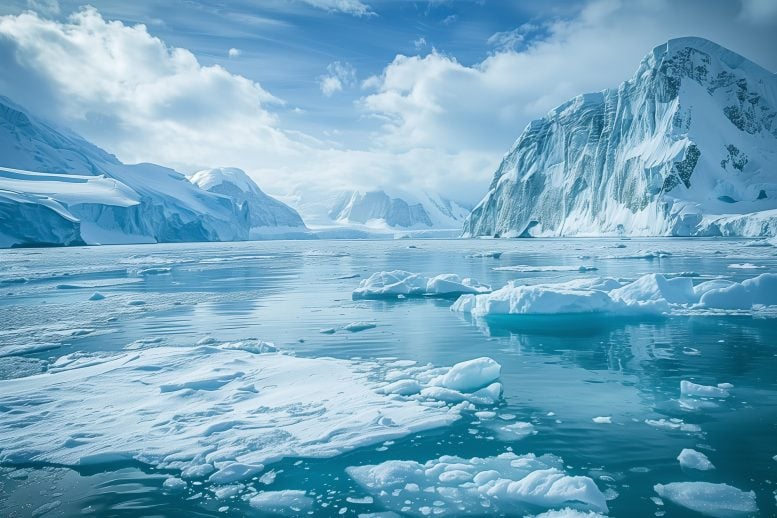
Recent research highlights significant changes at Earth’s poles, including shifts in ocean-sea ice dynamics and temperature extremes, with 2023’s record-low Southern Ocean ice potentially tied more to long-term warming than previously thought. Studies suggest the Antarctic is undergoing a “regime shift” in sea ice behavior, and differences in energy absorption between the poles could have far-reaching impacts on the climate.
New research published in journals of the American Meteorological Society indicate changes in ocean-sea ice interactions, moderated temperature variations, and varied reactions to sunlight.
New research recently published in journals of the American Meteorological Society demonstrates changes at the Earth’s poles, including altered ocean-sea ice dynamics, dampened temperature extremes, and differing responses to solar radiation at the north and south poles, and suggests that long-term warming trends may have played more of a role in 2023’s record-low Southern Ocean ice than previously supposed.
Three papers in the Journal of Climate (JCli) find that the Arctic and Antarctic appear to be adjusting to a warming climate with fundamental changes in regional climate dynamics.
The Antarctic ocean-sea ice system may be fundamentally changing.
A paper by Will Hobbs and colleagues from the Australian Antarctic Program Partnership at the University of Tasmania notes evidence that the Antarctic sea ice extent may be exhibiting a “regime shift.” While ice in the Southern Ocean plays a critical role in the Antarctic climate—for example, reflecting heat from the sun—the extent of sea ice in summer months has become increasingly variable since 2006, and more closely correlated with the previous month’s sea ice rather than the atmospheric factors that normally drive it. The authors’ statistical analysis suggests that interactions between sea ice and the ocean below may have fundamentally changed (possibly related to global warming), driving this increased variability.
“Perhaps the most striking change for scientists is that … the recent extreme fluctuations over the last decade can’t be explained by the atmosphere alone,” Hobbs said in an AAPP press release. “AAPP research shows that the changes we’re seeing—how much the sea ice can shift from its average state, and how long those shifts can stick around—are controlled by ocean processes. This is more evidence that ocean changes are probably the secret to what’s happened in recent years.”
The Antarctic is absorbing more energy than the Arctic.
Meanwhile, satellite data show differences in how the Arctic and Antarctic are responding to increased temperatures, according to a new paper by Hamish D. Prince and Tristan S. L’Ecuyer at the University of Wisconsin-Madison. Both poles are receiving increased solar energy input, as melting sea ice reduces the regions’ reflectivity. This may affect the temperature gradient between the poles and the temperate regions that drives much of the climate system. This study finds that the warming Arctic is emitting a nearly comparable amount of this increased heat back to space, leaving the region’s net energy imbalance largely unchanged despite rapid ice melt. However, the Antarctic is NOT emitting more heat energy to space, implying that solar radiation is being absorbed into the climate system there in ways that may affect both the Southern Ocean and atmosphere and Earth’s latitudinal heat balance.
“Our study provides a robust, observed record of a fundamental aspect of the climate system. Unlike the Arctic, where increased solar absorption is balanced by thermal emission, the Southern Ocean surface temperature remains insensitive to increasing absorption, accumulating additional energy,” says Prince. “The global impact of this contrasting polar response to reducing albedo may be far-reaching but is broadly unknown.”
Sea ice melt reduces seasonal Arctic extremes–especially cold extremes.
The third paper is by Igor Polyakov and colleagues from the University of Alaska, Fairbanks. It finds that, as melting sea ice exposes more humid ocean air, the differences between summer high and winter low-temperature extremes in the Arctic have been growing smaller since 1979. Across the Arctic, the authors find that average surface air temperatures have increased by approximately 0.62°C per decade. While the average has increased, summer hot extremes have become 25% cooler and winter cold extremes have become 200% warmer since 1979—a dampening of extremes that is only expected to continue as the Arctic warms.
“Our study shows a fundamental shift in the Arctic climate system toward increased mobility and a close connection between the atmosphere, ice sheet, and ocean,” says Polyakov. “This strong coupling makes it very difficult to understand the system’s behavior, necessitating a multidisciplinary approach in the research of Arctic climate change.”
2023’s sea ice low—El Niño? Or no?
Finally, a paper by Till Kuhlbrodt and colleagues in the United Kingdom, published in the Bulletin of the American Meteorological Society (BAMS), suggests that 2023’s record-high North Atlantic sea surface temperature and record-low Antarctic sea ice cover extremes were similar to what we might expect to see in a world that had reached the 3°C threshold of global warming. While many factors, including El Niño, have been suggested as the main drivers of last year’s extremes, the authors believe that these explanations may be insufficient. They note that trends of increased radiative forcing have been strong in recent years, and that sea-surface temperature and sea ice extremes were evident 8 to 9 months prior to the strongest effects of El Niño.
Till Kuhlbrodt (University of Reading) says, “Last year’s observed extremes in the North Atlantic and in the Southern Ocean are so concerning because they lie far outside anything we’ve seen in the 40 years before. While the acceleration of global heating will be a major contributor, our analysis of ocean data suggests that a regime change in the oceans could play a crucial role too.”
References: “Observational evidence for a regime shift in summer Antarctic sea ice” by Will Hobbs, Paul Spence, Amelie Meyer, Serena Schroeter, Alexander D. Fraser, Philip Reid, Tian R. Tian, Zhaohui Wang, Guillaume Liniger, Edward W. Doddridge and Philip W. Boyd, 13 February 2024, Journal of Climate.
DOI: 10.1175/JCLI-D-23-0479.1
“Observed energetic adjustment of the Arctic and Antarctic in a warming world” by Hamish D. Prince and Tristan S. L’Ecuyer, 9 February 2024, Journal of Climate.
DOI: 10.1175/JCLI-D-23-0294.1
“Modulated trends in Arctic surface air temperature extremes as a fingerprint of climate change” by Igor V. Polyakov, Thomas J. Ballinger, Rick Lader and Xiangdong Zhang, 31 January 2024, Journal of Climate.
DOI: 10.1175/JCLI-D-23-0266.1
“A glimpse into the future: The 2023 ocean temperature and sea-ice extremes in the context of longer-term climate change” by Till Kuhlbrodt, Ranjini Swaminathan, Paulo Ceppi and Thomas Wilder, 17 January 2024, Bulletin of the American Meteorological Society.
DOI: 10.1175/BAMS-D-23-0209.1









“Both poles are receiving increased solar energy input, as melting sea ice reduces the regions’ reflectivity.”
Both poles experience, nominally, about 6 months of darkness where reflectivity is unimportant. Therefore, all proposed changes related to reflectivity have to happen in the other six-months, the local Summer. The sun NEVER gets nearly overhead, as is common in the mid-latitudes. The specular reflectance off water varies with the angle of incidence, increasing with higher angles. Sunlight with high angles of incidence (sun low on the horizon) can have higher specular reflectance than the diffuse reflectance from snow; it can reach 100% at a glancing angle (90 deg).
Both poles are also notorious for frequent overcast, which is why the Vikings had to learn to use a sunstone to locate the hidden sun and navigate by it.
In summary, the role of ice in determining the net reflectivity tends to overstate the impact.
For more detailed information, go to:
https://wattsupwiththat.com/2016/09/12/why-albedo-is-the-wrong-measure-of-reflectivity-for-modeling-climate/
Note, especially, Figure 1, which shows the relationship between specular reflectance and the angle of incidence.
“… the recent extreme fluctuations over the last decade can’t be explained by the atmosphere alone,”
Climate is typically defined as the average weather over at least the last 30 years. They are using the behavior over the last decade to speculate on the climate, suggesting warming leading to high variability. Yet, “For the entire Antarctic continent, the winter of 2021 was the second-coldest on record [60 years], with the ‘temperature for June, July, and August 3.4 degrees Celsius (6.1 degrees Fahrenheit) lower than the 1981 to 2010 average at -62.9 degrees Celsius (-81.2 degrees Fahrenheit),’”
https://www.cnn.com/2021/10/09/weather/weather-record-cold-antarctica-climate-change/index.html
“This study finds that the warming Arctic is emitting a nearly comparable amount of this increased heat back to space, leaving the region’s net energy imbalance largely unchanged despite rapid ice melt. However, the Antarctic is NOT emitting more heat energy to space, implying that solar radiation is being absorbed into the climate system there in ways that may affect both the Southern Ocean and atmosphere and Earth’s latitudinal heat balance.”
This difference can probably be attributed to the fact that the Antarctic land mass, which isn’t susceptible to melting, lies between 66 (Antarctic Circle) and 75 degrees latitude. Only the western ocean area between 75 and 66 degrees has extensive pack and shelf ice. Whereas, The Arctic is surrounded by land, and as the pack ice melts, the winds can move it around, allowing open ‘warm’ water to radiate heat to space.